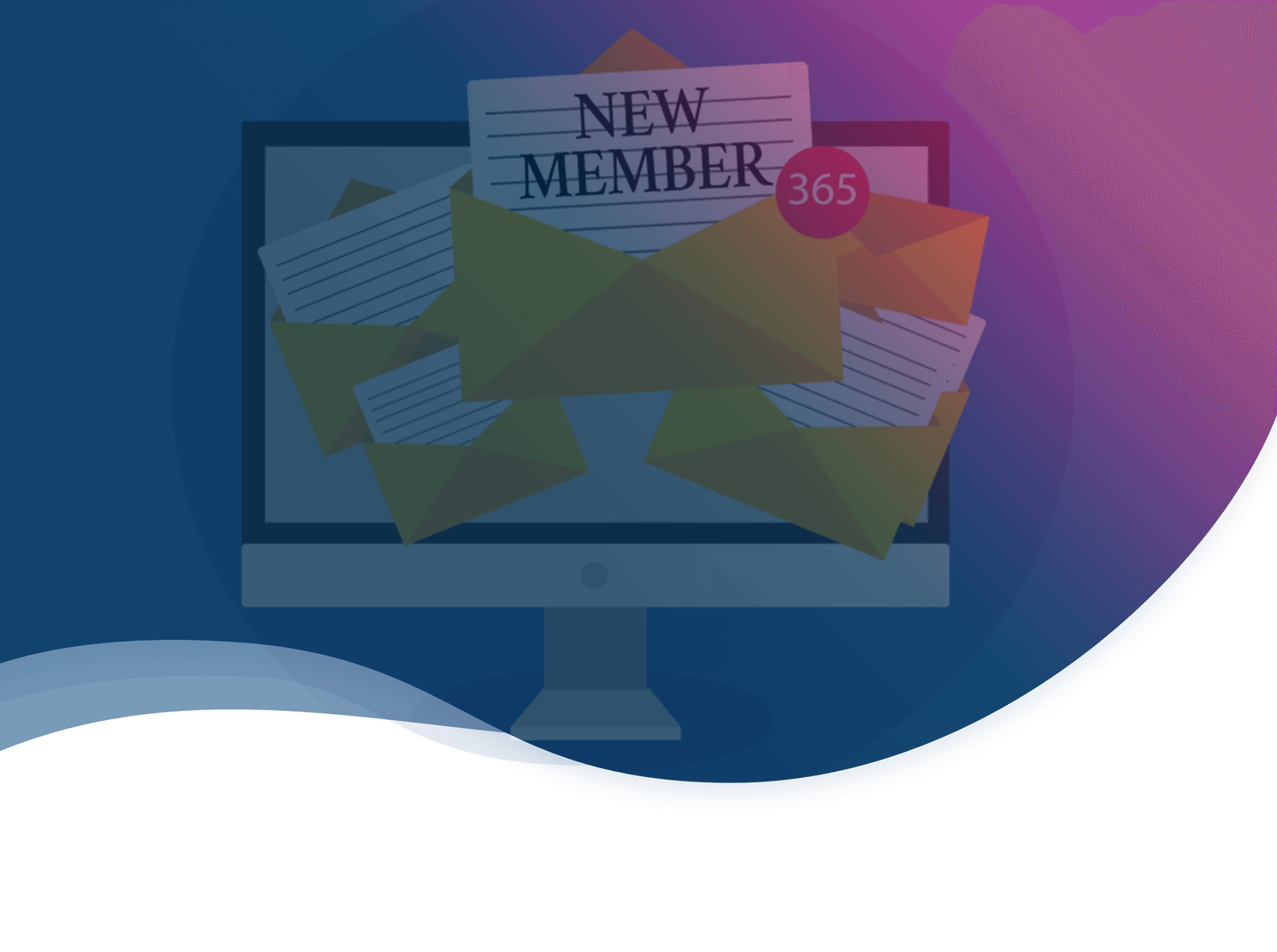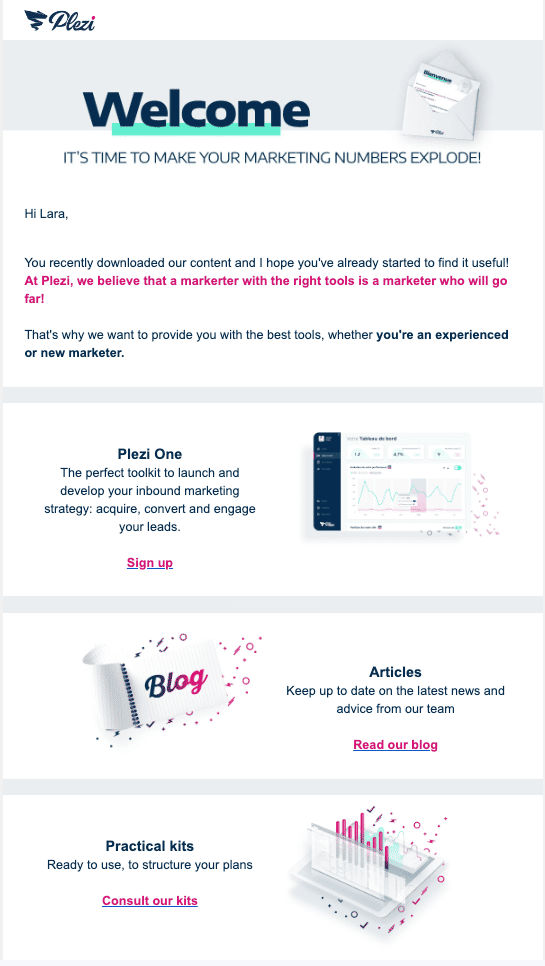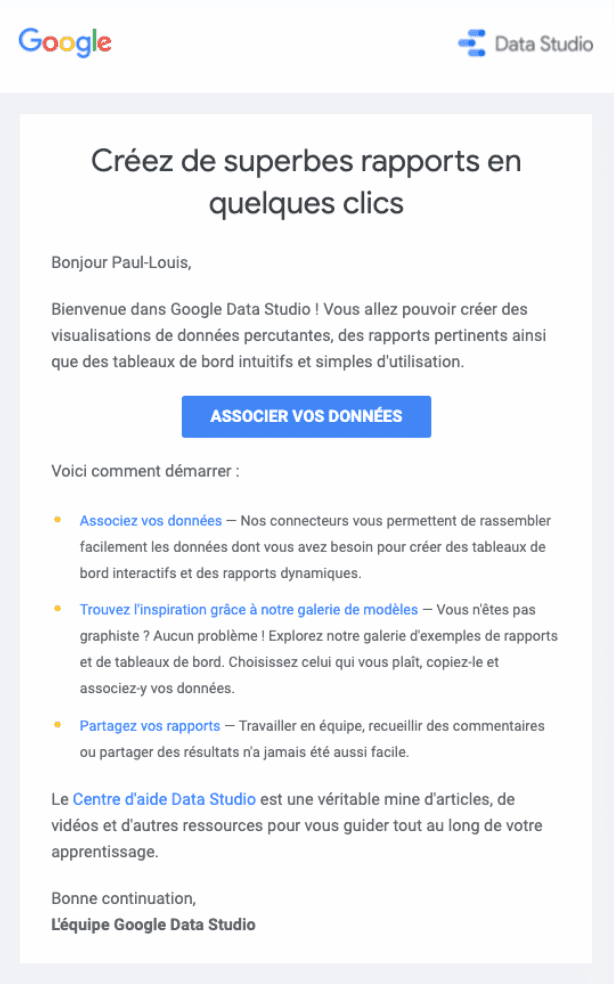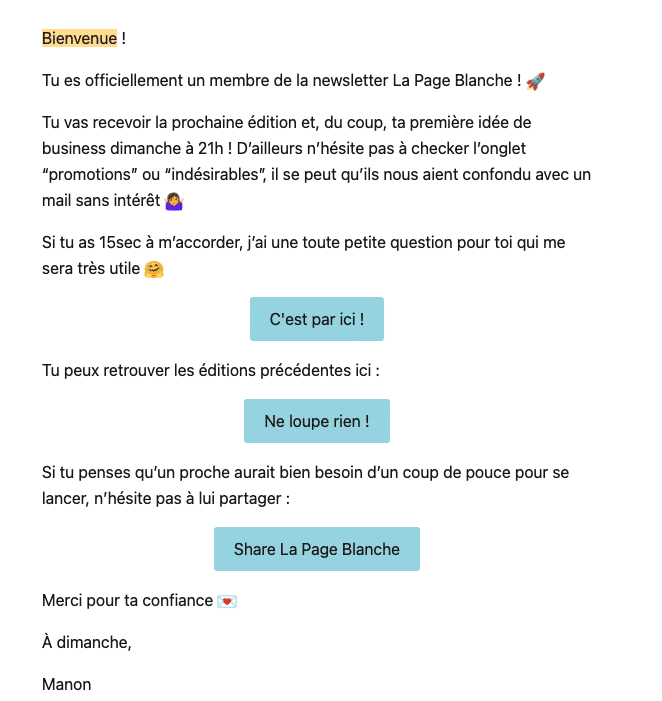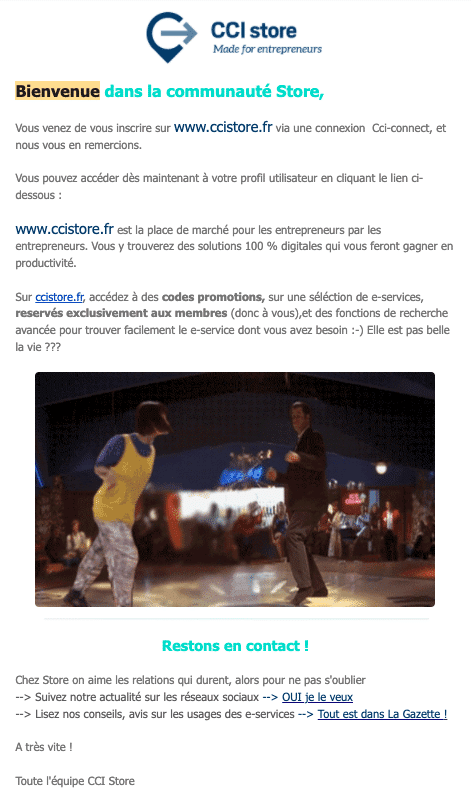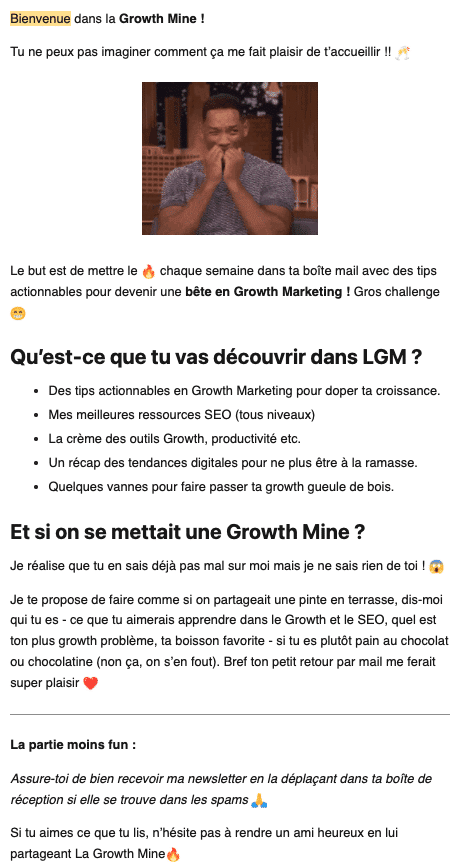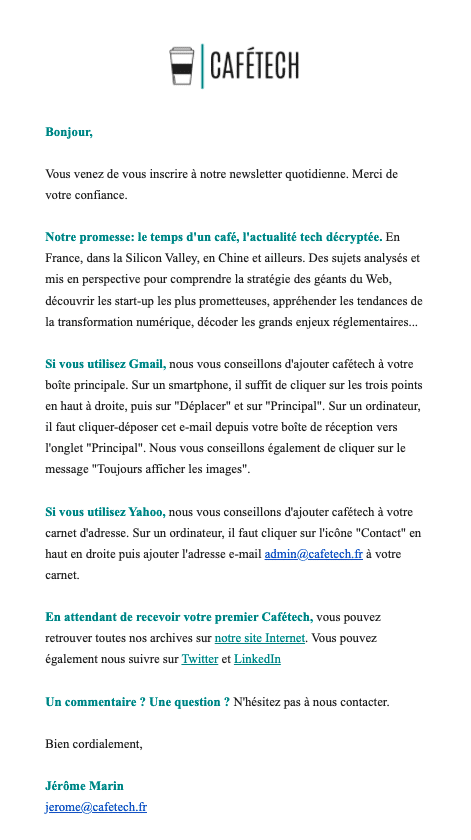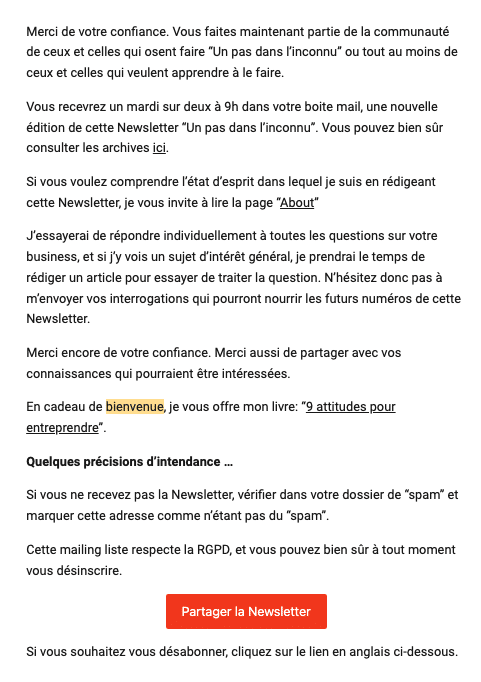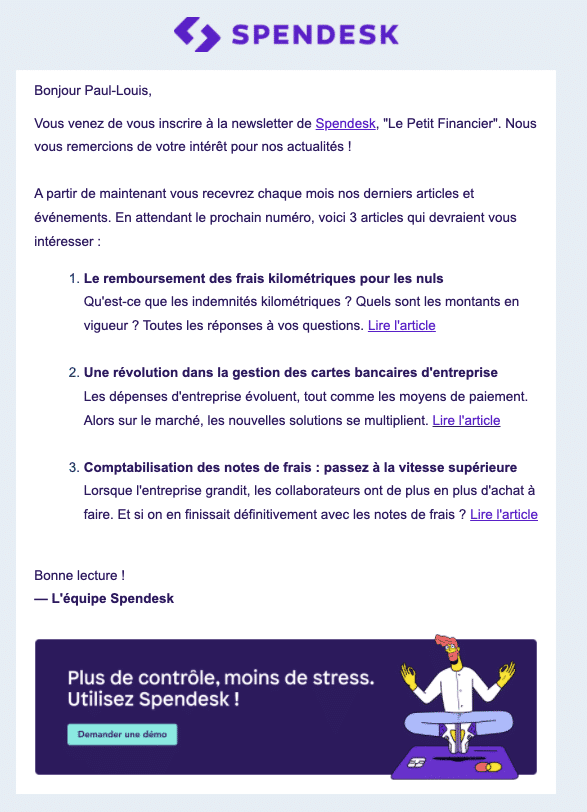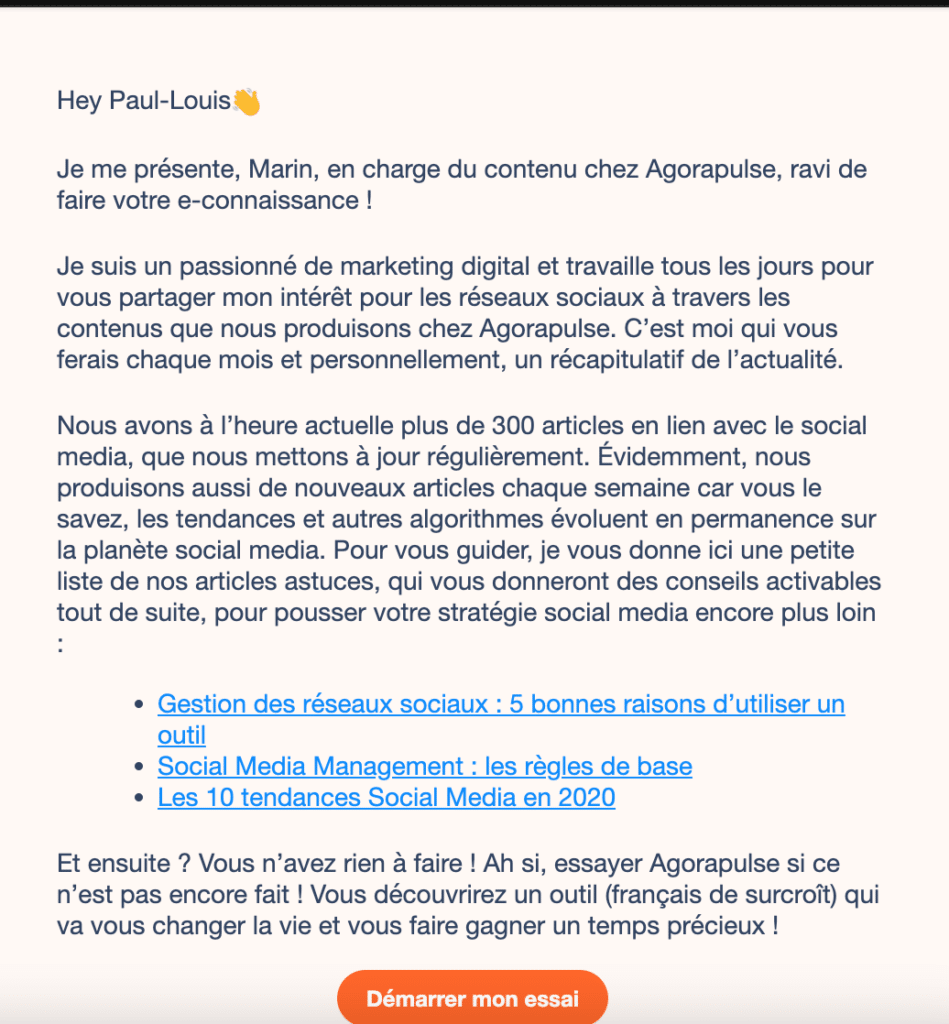A welcome email is often the first direct contact potential customers will have with your business. And if this email fails to hit the mark, you might never hear from them again.
In fact, we realized when we were writing this post that many companies still don’t send a welcome email to their new contacts or subscribers! So how do you go about writing a welcome email? And how can you make sure it’s effective?
In the post below, we’ll look at why a welcome email is so important to your leads, and how to write one that will help you turn new contacts into customers.
We’ll look at:
- What is a welcome email ?
- Why you should write a welcome email
- How to write an effective welcome email
- How to structure your welcome email
- 7 welcome email examples that work
- How to easily send a welcome email
What is a welcome email?
A welcome email is typically the first thing new subscribers or customers receive after interacting with your business. It’s usually automatically sent to new contacts after they’ve provided you with their email address. For example, after they have subscribed to your newsletter or downloaded content.
Why you should write a welcome email
Every marketer dreams of the ideal customer who comes to you and says, “I’m interested in your product or service, can you help me?”
But hundreds of thousands of new leads do this every day, all of them potential customers who are taking the first step towards your business. When someone visits your website and voluntarily provides you with their email address, they’ve literally asked you to contact them.
The best way to engage these potential customers who either download content (e.g., a case study, webinar, or white paper) or sign up to your newsletter is to automatically send them a welcome email as soon as they do.
This first email starts building a relationship between you and your new leads. It’s the perfect place to start connecting with them by welcoming them appropriately and making a good first impression.
Because you start to build customer loyalty from day one. And this is probably the most important email you’ll send, hence why you need to get it right.
If you look at metrics for welcome emails, you’ll soon see why you can’t afford not to send one. According to studies by GetResponse and Optinmonster:
9 out of 10 people open a welcome email.
Welcome emails have an open rate which is 86% higher than other marketing emails.
So, welcome emails are essential to building genuine relationships with leads.
1. How to write an effective welcome email
Thank your contact and explain why you’re sending the email
first thing to do in a welcome email is to thank the recipient for their interest in your content (or your product or service if they’ve sent a contact request) and for providing you with their contact details.
Also take the opportunity to tell them how often they will receive further emails from you, so they’re not taken by surprise.
Being transparent about your future actions will help you gain a lead’s trust. This will also increase the chances that they open further emails from you.
Every marketer has probably signed up to a newsletter without receiving confirmation that they’ve done so. And if you don’t know if you’ve successfully signed up or not, it doesn’t feel very reassuring.
In situations like this, a contact can easily forget that they’ve asked to be part of your community. That means they might not open your next email, especially if this is sent some time after they initially signed up (e.g., to a monthly newsletter). A welcome email serves as a reminder that they have signed up. That means there’s less chance they will forget that they’ve done so before your next email.
Yan Leonardi, who writes an email newsletter about growth marketing, is well aware of this. That’s why he sends a confirmation email to all new subscribers. He uses this to tell contacts how often they will receive his emails and even offers them a small welcome gift.
Have a great email subject line
If your welcome email is to really be effective, it needs to have a great subject line. It needs to encourage contacts to open your email and read it.
Here are some ideas for email subject lines to help you get started:
- Welcome [FIRST NAME]. Check out what’s waiting for you inside
- Congratulations [FIRST NAME], you’ve just made the best decision of the day!
- You’ve successfully signed up! What happens now?
- [FIRST NAME] + [COMPANY] = the start of a lasting relationship
- We’re proud to have you join us [FIRST NAME]
- Welcome [FIRST NAME]. Here’s a few links to start off on the right foot
- Welcome [FIRST NAME]. Let’s get to know each other better
- There’s a surprise waiting for you in this email [FIRST NAME]
- Welcome. Here’s what you can expect from [COMPANY]
Introduce your company and what makes it special
A welcome email is the perfect place to start to introduce new leads to the things that make your company unique. These include the graphic design elements and colours used by your brand. Your welcome email should therefore match your company’s visual identity. They also include the tone and language used in your writing. These things help establish your brand image and ensure your marketing strategy is consistent.
It’s important that new contacts know how your product or service works. But what really matters is how they can expect to interact with your business and the emotional response they have as a result.
At Plezi, our welcome email uses colours and icons taken from our website. This helps contacts to quickly recognize our emails from among the many they receive. From the outset, we introduce new contacts to our vision and what we can offer them:
Personalize your message and give it a human touch
A welcome email isn’t designed to sell your product or service. Instead, it should introduce your team and your business, and let contacts know how you can help them.
We’ve said it before, and we’ll say it again. Contacts should feel like they aren’t just another entry in your contact database, and that your company isn’t like their other contacts. So, you shouldn’t speak to them how companies usually address their leads (or customers).
Marketing automation can, and should, have a human face. And even if you automate the sending of your welcome emails, it shouldn’t feel like that to your contacts.
Using a contact’s first name in your welcome emails (“Hi Tony”) is a good start, but first name personalization shouldn’t end there. Your welcome email needs to seem like it was written specifically for this contact.
This means dropping the sales spiel and including a personalized email signature from someone in your company. At Plezi, we personalise our welcome emails as much as possible. We also try to show contacts how our emails can be of use to them as a marketer.
Guide a contact to take action
What do you want from contacts? Your welcome email needs to generate engagement from them and lead them to take a defined action. It does this using an appealing call to action that can’t be missed in the body of the email. But what action do you want them to take?
Depending on your product or service and your website, the next step might be to encourage contacts to do something like:
- complete their profile;
- download content;
- sign up to your newsletter;
- request an audit;
Whatever this action is, contacts should derive value from carrying it out.
Keep in mind that the more you ask from a contact, the less likely they are to do what you want. So, it’s better to encourage them to take one action at a time. This will increase the chances that they do so. The rule for generating engagement is therefore one email = one action to be carried out.
When you create a Google Data Studio account, you receive a welcome email that shows you how to start using the tool by including a CTA with the message “Link your data”. The colour of the button, its position, and the text in all caps indicate that this is an important part of their message.
Encourage new contacts to join your community
A welcome email is a great opportunity to ask new leads to follow your company on social media. There are a number of reasons for doing this:
It creates more of a connection with your customers.
It extends your relationship across different channels. This lets you stay in touch more easily, as well as show them another side of your business and what goes on behind the scenes.
You can make contacts feel part of your community by using inclusive language (“Welcome to the club Tony”).
Your interaction with leads will feel more human. Giving them your contact details and links to your social media accounts is a great way to strengthen your relationship.
Learn more about new contacts
You can make use of the enthusiasm of new subscribers to find out what their needs are in the welcome email. This is a good way to ensure that your future emails continue to meet the needs of your audience. Your leads will also see this as an attempt to get to know them better. This is how you start to build a genuine relationship with them.
You can get this information from contacts by simply asking questions or by including a form (e.g., a survey, poll) in your welcome email. Surveys are generally quite popular, so they can be a great way to learn more about the problems and challenges faced by your leads. It’s also a good place to ask them about things like their preferences regarding your products or services, and how often they want to receive emails.
Ask to be added to their list of contacts
It would be a shame to have prepared a great workflow to welcome new contacts and then not have them receive anything.
That’s why it’s a good idea to ask potential customers to add your email address to their contact list. This ensures your emails will go to their inbox and not their spam folder.
This is called “whitelisting”. Whitelists are key to all successful email marketing. They will help you improve the deliverability rate of your emails by ensuring that all your future emails arrive in a subscriber’s inbox.
If they use Gmail, you can ask them to add your address to the main inbox.
Track welcome email metrics
Once you’ve created a great welcome email, you can’t just automate it and forget about it altogether.
You need to keep a regular eye on the metrics of your welcome email. You should review how your welcome emails perform and see if they are delivering the open rates, click-through rates, and conversion rates that you want. If not, you need to have another look at your welcome email and see how it can be improved. This can involves changing elements like the email subject line or the call to action included in the email.
You can also try using different email subject lines, different email formats, or different CTAs and positions in the email. Once all parts of the welcome email are optimized, you can send the best version to new leads in the future.
How to structure your welcome email
You should include:
- A welcome section to welcome new subscribers and explain why they are receiving this email.
- A section that outlines what the person will receive from you and how often. It can also include a quick introduction to your business.
- A section that starts a conversation with new subscribers by asking them a question or which invites them to reply to the email.
- A section with your most popular posts to encourage the reader to click on them. You can give contacts free access to one piece of premium content to make them feel privileged.
- A CTA to encourage contacts to ask for a demo, a quote, or to find out more about your offer.
- Links to social media and a personal signature to give your email a human touch.
7 welcome email examples that work
1. La Page Blanche
With its flattering subject line and highly visible calls to action, this newsletter’s welcome email starts a conversation with subscribers and maintains a breezy tone throughout. It’s a good idea to ask where new subscribers come from if you can’t track all of your acquisition channels.
Subject: We’ve been expecting you!
2. CCI Store
The CCI Store draws on the community aspect of its network in this welcome email. They make it difficult to overlook future editions of their newsletter by advertising benefits like promotional codes and member exclusive offers. The writing is playful and the CTAs at the end are original and more effective than simple social buttons.
Subject: Welcome to CCI Store!
3. La Growth Mine
The subject line immediately sets the tone of this email. The personality of the newsletter’s creator, Myriam Mettouchi, really comes across. We also know straight away what to expect from future newsletters and it invites us to start a conversation.
Subject: Ready for a Growth Mine?🔥
4. Café Tech
The structure of this email makes it easy for readers to scan. You can quickly skip to the part that interests you the most. Both the topics covered by the newsletter and instructions on what to do next are nice and clear.
Subject: Welcome to Cafétech
5. Un pas vers l’inconnu
The mysterious subject line of this newsletter compels us read their welcome email. The link to this newsletter’s About page helps readers understand what it will cover. But what really grabs your attention is the gift of premium content offered to new subscribers.
Subject: Let’s go into the unknown
6. Spendesk
Spendesk starts building a relationship with readers here by giving them links to three of their most-read articles. New subscribers can also read these while they wait for the next edition of the newsletter. And because Spendesk never loses sight of its goal, a CTA at the end lets readers request a demo of their platform.
Subject: Confirmation of your subscription to our newsletter
7. Agorapulse
It’s difficult to stop yourself reading this welcome email once you’ve seen its tempting subject line. The next steps are clear, and readers are offered links to blog posts to read. After this, the all-important invitation to start a free trial of the platform seems much more palatable.
Subject: Welcome aboard! (Must read!)
How to easily send a welcome email
A welcome email doesn’t have to be sent by itself. Marketers often create a workflow of two or three automated emails to send to a new contact. This makes it much more likely that they will meet their retention and conversion goals for these leads.
The benefits of doing this are obvious. By sending several emails you can tell more of a story or create a common thread between emails. They also give you an opportunity to say more than you could in just a single email.
Plezi is a marketing automation tool that lets you easily create workflows in just 10 minutes. You can find out more about workflows in our post on how to create an effective marketing automation workflow.
Creating a workflow to welcome new contacts is a must because it’s so easy to set up. Automated emails that make use of Plezi’s forms and smart lists can more or less run all by themselves. As soon as a contact fills out the form, they enter the workflow.
And once you create the workflow, you no longer need to touch it. Here’s what our workflows to welcome new contacts (one in French and another in English) look like in Plezi:
Any relationship has to start somewhere. And with the right welcome email, you can start building a relationship based on loyalty.
Internet users are now bombarded with invitations to sign up to all kinds of emails. So, when one of them intentionally signs up to receive yours, you should relish the opportunity that this presents.
You now have everything you need to start creating a welcome email and sharing it to convert new subscribers into loyal customers. To help you do this, why not download our lead nurturing white paper?
What are your tips for creating an effective welcome email?
Marie-Francine Phan of Heaven Eden says, “Yes, I have a welcome email for new subscribers to my newsletter. And I give them a small gift (a practical guide) in return to thank them.”
Aurélie Veyer, digital project manager at O2 CARE SERVICE, says, “Small templates or things that can be printed out are always welcome. We tell subscribers what the next steps are and always use customer-focused language. We also tell them about what they can expect from us (the benefits they’ll receive). We also link to our platforms and social media accounts to maintain contact and make sure we don’t miss anything. But you can also be clear and succinct here (e.g., Welcome / Thank you, we’re so happy, we’ll be in touch soon with some surprises you’re going to love)”.
Do you have any tips for creating an effective welcome email? Why not tell us about them in the comments below ?




